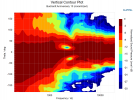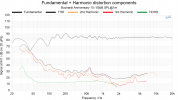This speaker is from Buchardt, a manufacturer based in Denmark. Someone purchased their 10th anniversary model and sent it to me for measurement.
In Korea, there's no official distributor for this product, so to acquire it, one would have to contact the Danish headquarters for a direct purchase… With its quite unique and attractive design, let's now take a look at the data of this speaker!
Frequency Response
The frequency response of this speaker is quite flat. There is a shallow dip of about an octave wide around 1-2kHz, which could be perceived as part of the speaker's unique tonal character. However, what concerns me a bit already is the low-frequency bandwidth.
This speaker uses a 6.5-inch woofer in a sealed design.
It's likely possible to extend the bandwidth(Bass) to such an extent with just a single woofer unit without the aid of a passive radiator or port because this is an active speaker.
While the exact intent behind the design is unclear, I believe it's quite a stretch to boost the lows that much with a single 6.5-inch unit in a sealed design.
Anyway, it has a bandwidth of about 25.5Hz at -6dB. Perhaps they tuned it so aggressively relying on the very powerful Purifi unit (the manufacturer of the woofer unit installed in this speaker)...
Nearfield Measurements
As expected, it shows a clean handling of good materials, with no particular anomalies. The crossover between the woofer and tweeter has been asymmetrically cut.
Directivity
The horizontal directivity is quite clean.
Due to the use of a very small 19mm tweeter unit, lowering the crossover point further must have been challenging. However, as a self-proclaimed high-end speaker manufacturer, I feel there's room for improvement in smoother control.
This is particularly noticeable around 2.5kHz, where there's a narrowing, likely due to this factor.
The vertical directivity shows a couple of significant null points near the crossover region.
Excluding these, the off-axis response appears to fall off quite smoothly.
Beamwidth
Overall, the beamwidth has a standard feel to it.
Still, thanks to the waveguide, the directivity in the high frequencies is well controlled, without any particular spikes or bulging.
The vertical directivity is quite narrow.
Particularly at the crossover point, the upward direction from the tweeter reaches the -6dB point at only about 10 degrees.
Polar plot
The appearance is uniform and beautiful, yet the region around 2kHz still seems lacking, which seems unavoidable.
However, despite this, the other pleasures that the 19mm tweeter offers might make this aspect tolerable for actual users.
I dare to speculate that the decision to drastically reduce the diameter of the tweeter was intended to push the vibrational partition and the resulting directional and various acoustic errors beyond the human audible range.
It reaffirms that the allowable vertical angle for faithful reproduction is not very wide.
THD
Purifi units are quite famous for their excellent design, guaranteeing faithful performance even at high displacements. However, I believe the failure resulted from choosing the smallest possible enclosure size that could accommodate a 6.5-inch woofer, and attempting to overcome all limits with EQ correction.
It would be better to just give up on the low frequencies.
(+20.12.2023)
Purifi products are well-known for their excellent design, which guarantees faithful performance even at high displacements. However, this speaker seems to be among the smallest in its class capable of accommodating a 6.5-inch woofer. It appears there were challenges in attempting to overcome the limitations of the unit's surface area and volume through EQ correction.
An output of 95dB SPL@1m puts this speaker under excessive strain.
Especially since it can't properly produce low frequencies due to its structure, yet is boosted with EQ, you can see the woofer unit struggling greatly.
As a sealed design, it showed quite a clean response in the 70-80Hz and above range, which is typical for speakers of this size.
However, due to the small internal volume, the proportion of second harmonic distortion in the lows starts to increase even from 85dB SPL.
As the internal volume of the speaker box decreases, there is less air, and the asymmetry in pressure increases when a woofer of the same size compresses and expands the air with the same displacement.
This leads to an increase in second harmonic distortion.
Multitone test
While I was somewhat prepared for this, I didn't expect it to this extent.
As a result of pushing a high-displacement capable unit to its limit, I observed very high Multitone Distortion across almost the entire spectrum.
80Hz~
The results are astonishing when I cut off the measurement signal below 80Hz and remeasured only the higher frequencies.
Indeed, by removing the low-frequency part that was overstrained in the speaker's design, I could see an incredibly clean response.
This speaker would likely show a completely different performance when used in conjunction with a subwoofer, cutting off the lows, rather than being used as originally designed.
The Multitone Distortion also significantly increases at the point where the low-frequency displacement expands.
The element that most highlights the shortcomings of this speaker is, indeed, the EQ design by the manufacturer.
Compression test
Again, despite the fact that this speaker could technically handle it according to its specifications, the excessive settings have led to undue compression.
Deviation
This time as well, since I received a pair of samples, I was able to measure the response variation between the two. The craftsmanship of the units and the design seems to be excellent.
Especially, most of the frequency range, from the lows to the ultra-highs, shows excellent linearity, staying within +/- 0.3dB.
However, there is a difference in the overall level. It seems that Sample B is set about 0.2dB lower than Sample A.
If only the level matching had been correctly done...!
(+20.12.2023)
In my reviews of speakers controlled via DSP, like Neumann KH120 ii, Genelec 8330A, 8351B, I wanted to suggest the aspect of amp level matching.
If the manufacturing process is not top-tier, encompassing in-house pair matching from units to the finished speaker, a variance within 0.5dB in the linearity of the final speaker product is commendable.
The Buchardt A10 I measured this time is insanely excellent in this regard.
However, the overall level being offset implies amp level matching. Considering the other performance aspects, I expressed a slight disappointment thinking, "For a company capable of handling details to this extent, they could have matched the amp levels a bit more precisely."
Grill test
This product comes with a round-shaped grill that attaches magnetically.
However, considering it distorts the response, and given the appealing appearance of the units and waveguide, I think I wouldn't use the grill on this speaker for any reason.
In conclusion, here are my personal thoughts.
Buchardt has been a manufacturer of interest to me for some time. They used sufficiently good materials, but I think they spoiled the end result with overly ambitious settings.
Despite having a 6.5-inch woofer, this speaker is very compact, with the trim ring's diameter and the enclosure's width nearly identical. I don't believe many users would expect deep bass in the 20-30Hz range from such a small speaker. (Expecting that might be unreasonable…)
Nevertheless, I think I will end up giving this speaker a fairly high score. If used with a subwoofer setting that cuts off the lows, it will show unbelievably strong performance for its size. Even without a subwoofer, if the user applies a suitable filter in the low frequencies considering the size, it will still deliver very reliable performance.
It's a bit disappointing that there was a 0.2dB difference in the amp level, but considering the variation in linearity between samples and the overall craftsmanship, there are enough aspects to give it extra points. Especially with the addition of the Scandinavian design aesthetic... I was quite satisfied.
But I must emphasize once again... if only they had been a little less ambitious with the bandwidth!
...That's all.
(+20.12.2023)
I apologize for any nuances lost due to my limited English skills and the use of translation tools, and for appearing overly strict and harsh in my evaluation, particularly towards Buchardt speakers.
As I mentioned in my previous comment, I hold this speaker in high regard. Additionally, I had some misunderstandings about the design intentions of this speaker until I heard the manufacturer's comments.
This speaker offers a proprietary system that allows for adjustment of bandwidth and curve, catering to both users who enjoy listening at low volumes in close quarters and home theater enthusiasts.
The default setting is sufficient to provide a deep bass response at low volumes, which is not typically felt in other speakers of similar size.
I also hope that mentioning the use of a translator doesn't come across as a poor excuse on my part. It is true that my evaluation may have seemed particularly harsh towards this speaker, and even though it was accompanied by affection, a more delicate revision was necessary for the nuances to be properly conveyed, which I failed to do.
However, thanks to Buchardt's explanation, I have gained a better understanding of the actual demands in a typical home environment, and for this, I extend my deep gratitude to the manufacturer.
Attachments
Last edited:



